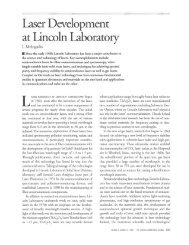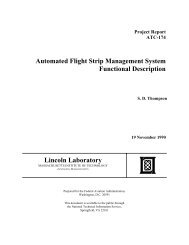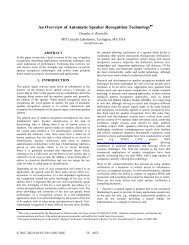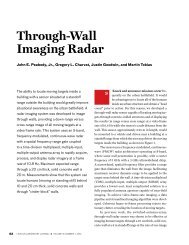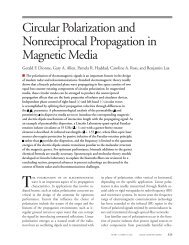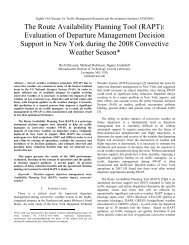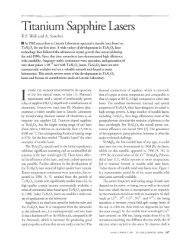2011 Annual Report - MIT Lincoln Laboratory
2011 Annual Report - MIT Lincoln Laboratory
2011 Annual Report - MIT Lincoln Laboratory
Create successful ePaper yourself
Turn your PDF publications into a flip-book with our unique Google optimized e-Paper software.
Airborne processor<br />
Lexington, Massachusetts) operations<br />
in December <strong>2011</strong>. A key enabler for<br />
full operation is a Pacific fiber-optic link<br />
from Kwajalein to Guam, which was<br />
emplaced in June 2010. A complete<br />
circuit connecting Kwajalein and<br />
Huntsville was established in fall 2010,<br />
and an Interim Authority to Operate<br />
at the classified level was granted<br />
in February <strong>2011</strong>.<br />
■ Work began on an Office of Naval<br />
Research future naval capabilities<br />
program that will provide integrated<br />
hard-kill and soft-kill engagement<br />
scheduling for future shipboard<br />
combat systems. The <strong>Laboratory</strong><br />
completed the design and coding,<br />
integrated the algorithms in a<br />
simulation test bed, and began<br />
generating performance results.<br />
LEADERSHIP<br />
Dr. Hsiao-hua K. Burke Dr. Andrew D. Gerber Mr. Gerald C. Augeri Mr. Dennis J. Keane<br />
Two-way<br />
communication<br />
with sensor turret<br />
located on aircraft<br />
FUTURE OUTLOOK<br />
Sensor turret<br />
ABOVE: In the Sensor Experimental System test<br />
facility, the <strong>Lincoln</strong> <strong>Laboratory</strong> prototype airborne<br />
processor is being integrated to a sensor turret<br />
(Raytheon’s Multi-Spectral Targeting System).<br />
The turret is designed to integrate with a Reaper<br />
unmanned aerial vehicle to support passive infrared<br />
missile tracking for the Airborne Infrared program.<br />
The sensor turret is shown here on a manned<br />
aircraft for initial flight tests.<br />
RIGHT: Infrared image created by the sensor. The<br />
Airborne Processor corrects the non uniformity of<br />
the focal plane data and produces target detection<br />
and tracking information.<br />
■ Increasing vulnerability of deployed U.S. forces to large attacks by medium-range and inter-<br />
mediate-range ballistic missiles mandates greater emphasis on improving regional BMD<br />
battlespace and raid-handling capabilities. The <strong>Laboratory</strong> will have key responsibilities in<br />
both Aegis BMD and the Missile Defense Agency’s (MDA) phased adaptive approach.<br />
■ The Navy and MDA are assessing how emerging sophisticated antiship missile threats<br />
may influence both Fleet operations and the need for improved air and missile defense<br />
capabilities. The <strong>Laboratory</strong> is helping with this assessment and with development and<br />
demonstration of near-term modifications for existing systems, as well as longer-term<br />
advanced capabilities, to respond to these threats.<br />
■ The Navy is looking toward developing advanced soft-kill capabilities to complement the<br />
hard-kill capabilities on which it has traditionally relied for ship self-defense, and toward<br />
providing better electronic protection for Navy radar and missile systems. The <strong>Laboratory</strong><br />
is helping to shape a technology portfolio to ensure that electronic warfare capabilities are<br />
adequately addressed across naval platforms and weapons systems.<br />
■ To enhance the credibility of deployed missile defenses, ground and flight tests must be<br />
planned and instrumented to verify the models and simulations relied upon by warfighters.<br />
<strong>Lincoln</strong> <strong>Laboratory</strong> will continue to have a major role in test planning, test range and<br />
instrumentation improvements, and capability assessment.<br />
<strong>MIT</strong> <strong>Lincoln</strong> <strong>Laboratory</strong> 29



